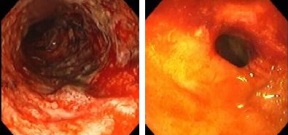Herbalzym is an alternative medical organization dedicated to developing treatment protocols for a diversity of diseases using natural medicine. For over 10 years, Herbalzym formula had been used with great success on so many terminally ill patients. It had been proven over and over again to be effective in clinical trials.
The cause of chronic inflammatory bowel disease (ulcerative colitis and Crohn’s disease) is unknown. However, exposure of the bowel immune system to infections is believed to play a role in the development of these chronic diseases that are very common among young people.
Some people with inflammatory bowel disease (IBD) may experience various extra-intestinal symptoms along with their gastrointestinal (GI) symptoms. These can include skin irritation (erythema nodosum), eye problems (episcleritis), and joint pains (arthritis). Some people with IBD also develop mouth sores (oral aphthous ulcers).
Behçet’s syndrome, an inflammatory disease affecting many organs, including the eyes, genitals, skin, joints, blood vessels, brain, and gastrointestinal, can cause recurring, painful mouth sores. Although the gastrointestinal and systemic features of Behcet’s syndrome and IBD overlap to a considerable extent, they are generally viewed as two …
Sulfur, after calcium and phosphorus, is the most abundant mineral element found in our body. It is available to us in our diets, derived almost exclusively from proteins, and yet only 2 of the 20 amino acids normally present in proteins contains sulfur. The sulfur-containing amino acids (methionine and cysteine) are found principally in red meat and dairy products. Proteins contain between 3 and 6% of sulfur amino acids. A very small percentage of sulfur comes in the form of inorganic sulfates and other forms of organic sulfur present in foods such as garlic, onion, broccoli, etc.
The metabolism of both sulfur containing amino acids is closely related. Methionine is one of the essential amino acids with many key roles in mammalian metabolism. It is a precursor for cysteine formation in …
Millions of people worldwide are affected by Ulcerative Colitis (UC) and Crohn’s Disease (CD), the two most severe digestive afflictions. Both diseases are classified under the medical rubric of IBD (Inflammatory Bowel Disease). Inflammatory mediators have been identified in IBD, and considerable evidence suggests that these mediators play an important role in the pathologic and clinical characteristics of these disorders. The result is an immune response that destroys normal body tissues. However, there is no scientific proof that IBD is an autoimmune disease. It is simply an assumption. The cause of IBD remains poorly understood.
 UC and CD share many extraintestinal manifestations, although some of these tend to occur more commonly with either condition. UC and CD cause life …
UC and CD share many extraintestinal manifestations, although some of these tend to occur more commonly with either condition. UC and CD cause life …
Metabolic abnormalities of tumor cells offer opportunities of therapeutic targeting. Tumor cells are more sensitive to methionine restriction than normal tissues, a phenomenon known as methionine auxotrophy. Methionine is one of the essential amino acids with many key roles in mammalian metabolism such as protein synthesis, methylation of DNA and polyamine synthesis but cannot be produced in the body, and so must be provided through our diet.
Many cancer cells and primary tumors have absolute requirements for methionine. Methionine-dependent increase in tumor cells is a specific metabolic defect. The biochemical mechanism for methionine dependency has been studied extensively, but the fundamental mechanism remains unclear. Methionine starvation can powerfully modulate DNA methylation, cell cycle transition, polyamines and antioxidant synthesis of tumor cells. Therefore, low methionine in the diet may be an important …
 Bitter melon is a member of the Cucurbitaceae family (cucumbers, pumpkins and watermelons). The bitter melon fruit, sometimes called bitter gourd or wild cucumber, grows in tropical and sub-tropical climates. It is very nutritious vegetable having high therapeutic value. It is used both as food and in medicine to treat type2 diabetes, cancer, infections, HIV (AIDS), menstrual disorder and immune disorders.
Bitter melon is a member of the Cucurbitaceae family (cucumbers, pumpkins and watermelons). The bitter melon fruit, sometimes called bitter gourd or wild cucumber, grows in tropical and sub-tropical climates. It is very nutritious vegetable having high therapeutic value. It is used both as food and in medicine to treat type2 diabetes, cancer, infections, HIV (AIDS), menstrual disorder and immune disorders.
Chemical constituents from whole plants, fruits, and seeds of bitter melon (Momordica charantia) have been isolated and described as following:
Glycosides: momordin, charantin
Alkaloids: momordicin
Others: polypeptide-P
Oils (seed only): stearic, linoleic, oleic acids
Glycoproteins: alpha-momorcharin, beta-momorcharin, lectins
Others: vicine (pyrimidine nucleoside), protein MAP30
Cucurbitane triterpenoids
Previously, the researchers have reported that extract of bitter melon has sugar- and fat-lowering properties. The compounds present in …
Signal transducer and activator of transcription-3 (STAT3) protein is a member of the STAT family of transcription factors which are initially located in the cytoplasm in their inactive form. STAT proteins are part of a group that is sometimes called DNA- binding factors. These proteins bind to DNA sequences, and therefore control the transcription of information from DNA to mRNA. A variety of growth factors and cytokines activate STAT3 by phosphorylating the tyrosine residue in the STAT3 transactivation domain. Phosphorylated STAT3 (p-STAT3) then translocates into the nucleus and induces the expression of a wide variety of target genes involved in tumorigenesis.
Tumor cells depend on STAT3 for continued rapid growth and avoidance of apoptosis. STAT3 is constitutively activated in a wide variety of tumours, including colorectal cancer, liver cancer, breast cancer, …
As discussed in our previous article, PFK1 (phosphofructokinase type 1) is a major regulatory enzyme in glycolysis.
Anti-tumor activity of Herbalzym Vinegar by disrupting cancer cell metabolism
PFK1 is an allosteric enzyme made of 4 subunits and controlled by many activators and inhibitors. PFK-1 catalyzes the important “committed” step of glycolysis, the conversion of fructose 6-phosphate and ATP to fructose 1,6-bisphosphate and ADP.
PFK1 is allosterically inhibited by high levels of ATP but AMP reverses the inhibitory action of ATP. Therefore, the activity of the enzyme increases when the cellular ATP/AMP ratio is lowered. Glycolysis is thus stimulated when energy charge falls. PFK1 has two sites with different affinities for …
The Warburg effect describes a pro-oncogenic metabolism switch such that cancer cells take up more glucose than normal tissue and favor incomplete oxidation of glucose even in the presence of oxygen. Most cancer cells exhibit increased glycolysis (the Warburg effect) and use this metabolic pathway for generation of ATP as a main source of their energy supply. A number of studies suggest several possible mechanisms by which this metabolic alteration may evolve during cancer development. These mechanisms include mitochondrial defects and malfunction, adaptation to hypoxic tumor microenvironment, oncogenic signaling, and abnormal expression of metabolic enzymes.
The glycolytic switch occupies a privileged position in the aggressive agenda of most solid tumors. As such, switching to a glycolytic metabolism may precede the evolution of tumors toward the more aggressive angiogenic and metastatic phenotypes. …
Cancer cells must satisfy the metabolic demands of fast-growing cancer within a continually changing microenvironment. The metabolism of cancer is approximately 8 times greater than that of normal cells and the body is constantly overworked trying to feed it. A fundamental difference in sugar metabolism exists between tumor cells found in the hypoxic regions of most solid tumors and the majority of normal cells in the body, which are under oxygen.
Sugar, or glucose, is brought into cells and converted into useable energy, a molecule called ATP. Another product of this conversion, a molecule called lactate, is then taken out of the cell by specialized transporters. Glucose is metabolized by glycolysis in a multi-step set of reactions resulting in the creation of pyruvate. In normal cells, much of this pyruvate …
Melatonin, the so-called sleep hormone, is a molecule secreted by the pineal gland – a pea-sized gland located just above the middle of the brain. During the day the pineal is inactive. When the sun goes down and absolute darkness occurs, the pineal is “turned on” and begins to actively produce melatonin, which is released into the blood. Thus, serum melatonin levels have been found to be high at night (80–120pg/ml) and low during the day (2–20pg/ml).
The pattern of waking during the day when it is light and sleeping at night when it is dark is a natural part of human life. Only recently have scientists begun to understand the alternating cycle of sleep and waking, and how it is related to daylight and darkness.
In addition to its well-known regulatory …